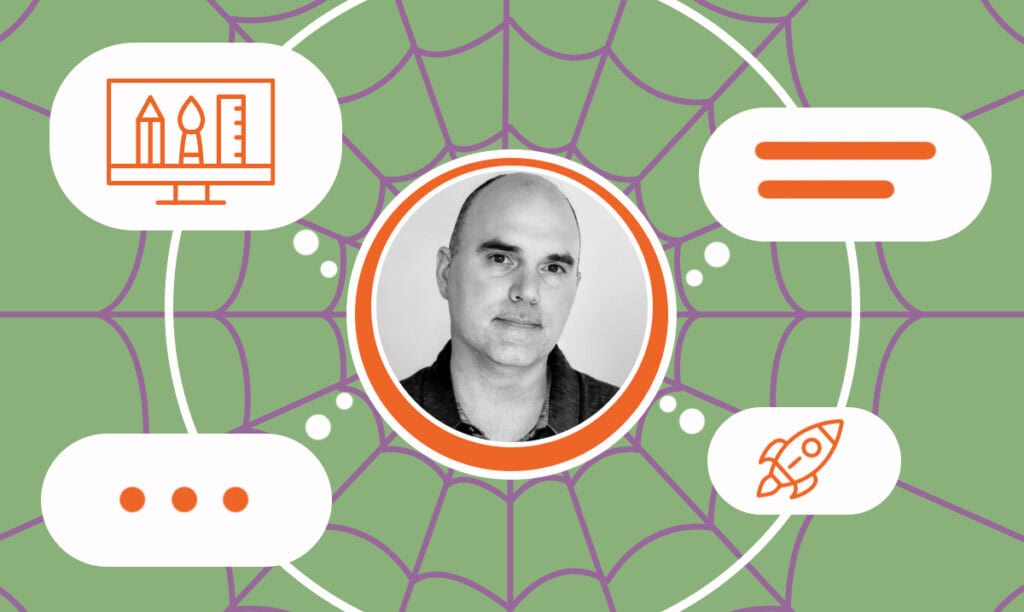In today’s interview, we’re joined by Felix Norton, the managing director of Woww, a digital agency renowned for its WordPress webdesign ...
How to Align Your Brand and Web Presence for Success
Written by: Howard Tillerman
Howard Tillerman is the Chief Marketing Officer for Step By Step Business and an award-winning marketing professional.
Published on May 22, 2024

Rodney Warner, chief executive officer of Connective Web Design, leads a Houston-based company dedicated to crafting digital solutions that enhance online presence through web design and digital marketing. The interview explores how strategic web development and SEO can significantly impact business growth, offering valuable insights for entrepreneurs seeking to elevate their digital footprint.
Starting Your Web Design Journey
SBS – What is the first step you recommend to businesses considering a new website or a website redesign?
Rodney – One of the first things I talk to my clients about is the goal of their website so that I can assess how effective their current website is and how we can actually help. It is important to know what the website is meant to do — whether it’s to increase checkouts, attract investors, generate leads, establish industry authority, enhance brand reputation, or get more exposure. That way, you can create a site that is not only attractive but aligned with their goals. Besides that, we have an extensive discovery questionnaire, which includes the client providing their USP, target audience info, tastes, tone of voice, etc.
Aligning Brand Identity with Website Design
SBS – How do you ensure that a website aligns with a brand’s identity and values?
Rodney – To make sure a website matches what a brand stands for, we start by getting to know the brand really well through the aforementioned discovery questionnaire. It goes deep into their previous branding strategies, branding goals, and current brand standing. After we’ve completed our research and reviewing of the onboarding survey, we chat with them to figure out their mission, values, and the message they want to share. It is more often than not important to hear what individuals say when simply asked what their brand stands for, and this face-to-face conversation helps us understand what the essence truly is that resonates with the team. This document becomes a source of truth and is referenced by everyone who touches on the project from start to finish.
Common Web Design Challenges and Solutions
SBS – Can you describe a challenge you frequently encounter in web design and how you overcome it?
Rodney – In web design, we aim to balance aesthetics, functionality, and the client’s priorities. This can become challenging, especially when a client has a corporate board, and everyone tends to have their own take on what the website should look like.
This is where diligent research comes into play to make a solid case that every user experience choice of ours is rooted in customer data and diligent analysis. We don’t want a beautiful design that makes the website hard to use or alienates the customer’s current user base. To do this, we follow user-centered design principles. We think about the user’s journey from the first moment they might even see the company brand or website link to how they will be greeted once they land on the website itself.
We test the website with real users at different stages of the design process to get feedback on how they use it. This feedback is important as it helps us decide on design changes that improve the site’s looks and performance. This repeated process helps us find the right balance so that the final product is both attractive and user-friendly.
Approaching designs this way, where multiple stakeholders are involved, is great because it removes opinion from the equation.
Future Trends in Web Design
SBS – What trends in web design do you think will be most influential in the next few years?
Rodney – In the coming years, web design will be shaped by several key trends, making it an exciting period to witness.
Firstly, mobile-first design is crucial as most users now access the web via mobile devices. This is a trend that will only accelerate with the rise of touch-based tablets replacing traditional mouse and keyboard setups in consumers’ homes. This approach ensures optimal user experiences across all platforms, which is essential for user retention.
Additionally, AI and machine learning are becoming integral in customizing user experiences. They analyze behaviors and preferences to serve relevant content, enhancing engagement and satisfaction. We can already see this in immediate customer chat support and algorithmic product recommendations, but soon, we expect to see even more personalized features like customized imagery and AI-generated video greetings tailored for every visitor.
Accessibility will also be a significant focus, aiming to make web interfaces usable for everyone, including those with disabilities. This involves adhering to design standards that support assistive technologies, expanding user bases, and meeting legal requirements.
The trend of minimalism and simplicity in design will also continue, now with a higher emphasis on personalized messaging. Emphasizing clear layouts and minimal cognitive load remains extremely important, benefiting both usability and site performance.
We’ve also seen more expressive design trends such as neomorphism emerge, but as we shift toward touch-oriented devices, we also need to look forward to special VR/AR devices that could widely adapt immersive elements like 3D graphics into web design realms. The adoption of various mixed-reality devices could completely change how we interact with websites and brands.
Evaluating Website Success Metrics
SBS – How do you measure the success of a website you’ve developed?
Rodney – We use a mix of quantitative and qualitative metrics to evaluate the websites we build.
Quantitative metrics, essential for understanding user interaction, include traffic volumes, page views, bounce rates, and conversion rates. These figures help us assess how well the website converts visitors into customers or leads. We also track specific goals set in analytics tools, like form submissions, downloads, or purchases, which align with the business objectives defined at the project’s outset.
Qualitative metrics involve gathering user feedback through surveys, user testing sessions, and usability studies. This feedback reveals whether the website meets users’ needs and expectations.
Misconceptions in Web Development
SBS – What are the common misconceptions business owners have about web development and online marketing?
Rodney – Some business owners misunderstand web development, thinking that a website is a one-time project. However, a website needs regular updates and management to remain secure, functional, and relevant — all essential for a strong online presence. This is why we emphasize providing regular maintenance and marketing services. For a website to achieve its full potential, consistent inbound traffic through organic platforms like social media posts, email newsletters, or referrals is important.
Another common misunderstanding is that online marketing produces instant results. Many expect SEO tactics or advertising campaigns to quickly increase traffic or sales, but effective online marketing typically requires time and steady effort to see meaningful results. SEO is a long-term strategy that builds trust and reputation, which can take months to significantly impact rankings and traffic.
Integrating SEO in Web Design
SBS – How do you approach SEO in your web design to ensure high visibility on search engines?
Rodney – The first part is having a great foundation. We focus on making our websites easy to use, quick to load, and optimized for mobile devices. Without these, a site will never perform well.
We then conduct keyword research to know what users want and produce content that meets their needs and boosts rankings. We map this keyword research to each page of the website and implement it in URLs, title tags, meta descriptions, and throughout the content. We don’t believe in keyword stuffing, and Google is smart enough to know what a page is about, but it’s important to have this info while making decisions.
However, we don’t stop there. We offer many services designed to generate high-quality traffic to the website. Link building, PR Outreach, social media, and continuous content development all play a huge role if budgets allow. We monitor our site’s performance and adapt strategies as necessary, which helps us maintain visibility and relevance in search results.
Best Practices for Conversion Rate Optimization
SBS – What strategies do you find most effective for conversion rate optimization on a new website?
Rodney – In a perfect world, we can run Google Ad campaigns and experiment with single-variable tests. We can test headlines, images, and the placement of key conversion items like forms or phone numbers. Then, we can iterate forever.
The learnings we can gain from this approach are invaluable, as we can then apply them to the front-facing website.
Impactful Web Design: A Client Success Story
SBS – Could you share a case study where your web design significantly impacted a client’s business growth
Rodney – We’ve supported a law firm’s growth for over a decade by managing various web design and digital marketing aspects. It’s been a challenging journey, especially given the niche nature of their specialty.
Initially, we focused on refining their website, which has undergone multiple redesigns both visually and contextually as the firm expanded. Our goal was to make the site appealing and user-friendly, featuring a resource section that showcased their legal expertise and credibility.
We took over their social media and SEO to boost exposure and engagement with potential clients. Our content featured client testimonials and legal advice and showcased their expertise. We created educational videos on wealth management and legal matters, gaining over a million views.
Finally, helping them dominate in paid search and paid social media has allowed us to scale.
All of this has resulted in taking the firm from barely making it to nearly an eight-figure business.
Keeping Up with Digital Marketing Trends
SBS – How do you keep up with the constantly changing landscape of digital marketing and web technology?
Rodney – We prioritize ongoing education and regularly participate in workshops, webinars, and conferences to learn new technologies and trends. We’ve also recently added a new team member who helps us with anything related to AI advancements and how our team can use AI ethically and effectively to improve our team’s productivity and operations. We view these technological advancements as chances to grow and use new tools to further enhance our company operations. This has expanded our knowledge and also enabled us to network with industry leaders and innovators.
We provide continuous training for our staff, ensuring they are skilled in the latest tools, platforms, and programming languages. This skill is essential to providing high-quality service to our clients. We also allow time to read leading industry publications and blogs, which offer us useful insights into emerging trends, case studies, and practical tips that we can use in our projects.
We believe in the value of hands-on experience. We test new tools, strategies, and ideas on our own projects before implementing them for clients. This trial-and-error approach allows us to evaluate the effectiveness of new methods in real-world situations.
Boosting Online Presence on a Budget
SBS – What advice would you give to a small business on a limited budget looking to improve its online presence?
Rodney – The first thing would be to make sure all of your marketing materials are geared toward solving your target audience’s problems. Don’t talk about yourself. Talk about them, their situation, and how you can help them solve their problems.
Be a content machine. Create content that helps and answers your audience’s questions. These can be blogs, videos, or infographics and can be published on your site and social media. Good content can boost your SEO, increase organic traffic, and make you a leader in your industry.
Do your best to optimize for SEO. Make sure your website and content are friendly for search engines. Use the right keywords, meta tags, and mobile design. SEO is slow but effective for getting more visitors.
Utilize Google My Business. A Google My Business account is important for local businesses. It’s free and can make you more visible in local searches and maps, helping customers near you find you more easily.
Monitor and adapt. Use free tools like Google Analytics and Google Search Console to track your website’s performance. Know where your traffic comes from, what pages visitors like, and how they use your site. This data can help you decide where to put your efforts and how to change your strategies for better results.
Small businesses need to be smart and patient when enhancing their online presence. Build a strong base with great content and SEO, connect sincerely with your audience, and use data to guide your actions. These steps can help your business achieve online success without spending much money.
Fostering Creativity in Web Design Projects
SBS – How does your team stay creative and innovative when designing new websites?
Rodney – We want our web design team to be creative and innovative. We do this by having brainstorming sessions with our art director and people from other departments for diverse ideas. We encourage all team members to share articles and videos about the latest trends, technologies, and tools in web design, development, AI, and whatever comes to mind in our Slack channels.
We also do our best to invest in continuous training to learn new software, techniques, and UX strategies. This sometimes includes our Asana platform tickets dedicated to education and giving an employee 5–15 hours just to explore something, or sometimes rewarding them for something they’ve done on their own.
It’s extremely important to understand that feedback is a two-way street, and nobody is above anyone else. Every person’s feedback is valued, and we need to understand where they come from and why they have such a reaction to any design, development, or business choice. This is why we encourage open communication and humor, even if I, as the CEO, do something wrong or hilariously “old school.”
Post-Launch Website Support
SBS – What are the long-term support and maintenance services you offer post-website launch?
Rodney – As part of our long-term support and maintenance services, we ensure that your website stays safe, functional, and up-to-date after we launch it. This includes regular updates, testing, and management, which keep things running tip-top. We also offer ongoing marketing services, such as PPC, SEO, social media, and more, to help get eyes on your site.
Subscribe to Our Newsletter
and gain insider access to cutting-edge business insights and trends.
Featured Resources

Felix Norton’s Website Design Tips for Small Businesses
Published on April 11, 2024
Read Now

Phillip Stemann Talks SEO Strategies and Trends
Published on March 8, 2024
Meet Phillip Stemann, the force behind the renowned SEO consultancy service phillipstemann.com. With a rich background melding technical prowess and ...
Read Now

The DKDesigns Story of Bridging Web Design Gaps
Published on January 18, 2024
In this insightful interview, David Gilbert, the founder of DKDesigns, shares the compelling journey and innovative strategies behind theestablishme ...
Read Now
Comments